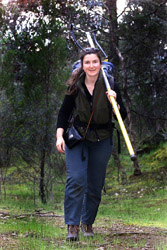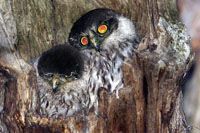The incessant trilling of the baby barking owls heralds we are close to their nest. “These are my ‘bombproof’ owls, the ones least disturbed by human presence,” says Natasha Schedvin as we make our way quietly though a forest of black cypress pine and red and long leaf box trees.
 Natasha is a PhD student at Charles Sturt University’s School of Environmental and Information Sciences at the Thurgoona campus in NSW and a member of the Johnstone Centre for Research in Natural Resources and Society. For the past three years she has been researching barking owls, an endangered species in Victoria. Over that period, she has tracked 13 owls for 130 nights in and around Chiltern-Pilot National Park, in the North East. Up until the 2002 bushfires this area had one of the densest populations in south-east Australia.
Natasha is a PhD student at Charles Sturt University’s School of Environmental and Information Sciences at the Thurgoona campus in NSW and a member of the Johnstone Centre for Research in Natural Resources and Society. For the past three years she has been researching barking owls, an endangered species in Victoria. Over that period, she has tracked 13 owls for 130 nights in and around Chiltern-Pilot National Park, in the North East. Up until the 2002 bushfires this area had one of the densest populations in south-east Australia.
This particular breeding pair, who reside in the Woolshed Valley, is the most successful of the 23 pairs Natasha has studied. Over the past four years they have raised three chicks (the maximum number for barking owls) annually. A male owl, large and unperturbed, is perched on a low branch. As we approach he just bothers to open his distinctive yellow eyes. Later, the female swoops from tree to tree, issuing a warning call that explains why these owls have earned the name the “screaming woman” owl. The female owl is the smaller of the two, weighing around 600 grams, compared to the male’s 800 grams.
There are three chicks in the nest in the hollow of a dead tree but only two make an appearance. Fortunately the pair’s nesting tree (and the pair) was spared in last year’s bushfires which burnt much of the barking owls’ natural habitat and destroyed six of the nesting sites Natasha had been observing.
“The situation last breeding season was very, very poor,” says Natasha. “My population of 23 pairs is now down to nine, and of those pairs, only two successfully produced young. We don’t have owls nesting in the burnt areas any more.” One of the reasons the bushfires were so devastating was owls are very territorial and don’t move to new locations easily. Breeding pairs seem to stay and defend their patch at all cost. “With the coincidence of drought and the fires they’ve been a double whammy,” says Natasha. “As any landholder knows the impact of a drought is felt for some time after it finishes. I would expect the combination of the two has resulted in a lack of abundant food sources required when owls are breeding. It’s been very sad.”
One of the key contributing factors to the previously abundant barking owl population is the large connected blocks of box-ironbark woodland present in Chiltern-Pilot National Park and its surrounds.“It’s one of the forest types we’ve lost a lot of in Australia,” says Natasha whose research is looking at the owls’ habitat requirements with a view to further refining conservation management practices.
The southern sub-species of barking owl was once widespread across the east coast of Australia and the south west corner of Western Australia. It is a woodland bird found in the foothills of the Australian Alps and in the river red gum forests along the Murray. “They seem to be declining but we don’t know why yet,” says Natasha. “The northern sub-species is doing quite well but it’s a different case down south.”
 Barking owls are listed as endangered in NSW and Victoria and as rare in South Australia. Owls are at the top of the food chain and eat lots of creatures like bats, possums and parrots and even other endangered species like squirrel gliders. “Given this broad and varied diet, you would expect them to do well in all sorts of environments so the question is why aren’t they?” she says. “They seem to like the edges of woodlands that abut pastures, the more fertile sites and strips along the drainage lines. This country is productive and provides more prey for them to live on. I am hoping my analysis will highlight the extent of what it is about the species habitat’s characteristics that impact on their survival.”
Barking owls are listed as endangered in NSW and Victoria and as rare in South Australia. Owls are at the top of the food chain and eat lots of creatures like bats, possums and parrots and even other endangered species like squirrel gliders. “Given this broad and varied diet, you would expect them to do well in all sorts of environments so the question is why aren’t they?” she says. “They seem to like the edges of woodlands that abut pastures, the more fertile sites and strips along the drainage lines. This country is productive and provides more prey for them to live on. I am hoping my analysis will highlight the extent of what it is about the species habitat’s characteristics that impact on their survival.”
Barking owls use large old trees as nesting hollows (as does much of the wildlife they prey on) which in many areas are a limited resource. “We don’t know much about our large forest owls,” says Natasha. “In fact we don’t know much about our owls full-stop.” Natasha has spoken to and worked with members of various Landcare groups in the region in the Wooragee, Indigo Valley, Chiltern, and Springhurst/Byawatha areas. She is known as “the barking owl lady”, especially among the 80 or so landholders who allowed her to access their properties. “Many of them have been very hospitable and interested and some have helped me trap owls,” says Natasha who, as a thank you, organised a barbeque with donated supplies of barking owl wine from Millbrook Winery in Western Australia.
Meanwhile, barking owls remain listed as endangered in Victoria, threatened in NSW, and as rare in South Australia.